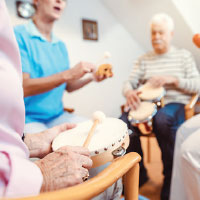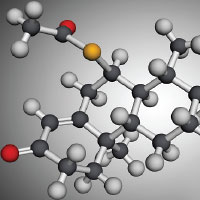Journal Digest: Musical Training; Hypertensive Medication; Mindfulness Intervention; and More
Musical Training Improves Facial Memory

Research has shown that learning to play a musical instrument can improve multiple aspects of cognition in older adults such as temporal attention and working memory. A study appearing in PNAS now shows musical training can also improve the ability of older nonmusicians to remember faces.
The study by investigators at the University of California, San Francisco, involved 47 adults aged 60 to 79 who had less than three years of formal music instruction and had not played an instrument in the previous year. The participants were randomly assigned to play a music rhythm game (using visual clues to tap out a percussion beat) or a word search game. Both groups were asked to train for 20 minutes daily, five days a week over eight weeks. Before playing the games and after the end of the eight-week period, the participants performed a facial memory task while hooked up to an electroencephalography (EEG) device.
At study’s end, only the adults who completed the rhythm training showed a significant improvement in facial short-term memory. The EEG data suggested this improvement was not due to enhanced attention or sensory perception, but rather due to activity changes in the brain’s right superior parietal lobule—a region involved in memory encoding and retrieval.
“Overall, these results contribute to a growing literature indicating musical training yields cognitive benefits on nonmusical short-term memory tasks,” the investigators wrote.
Zanto TP, Johnson V, Ostrand A, Gazzaley A. How Musical Rhythm Training Improves Short-Term Memory for Faces. Proc Natl Acad Sci USA. 2022; 119(41): e2201655119.
Hypertensive Medication May Help Treat AUD

Spironolactone, a diuretic used to treat hypertension and heart problems, may be a promising treatment for alcohol use disorder (AUD), according to a report in Molecular Psychiatry. Spironolactone regulates the activity of the hormone aldosterone, which has been linked with memory formation, stress response, and cravings.
A team led by the National Institute on Drug Abuse and National Institute on Alcohol Abuse and Alcoholism tested the effects of spironolactone on mice and rats given access to an alcohol-infused solution and alcohol vapor, respectively. The mice received 50 to 200 mg/kg of spironolactone, and the rats received 25 to 75 mg/kg of spironolactone.
The higher the dose of spironolactone the mice received, the less of the alcohol-infused solution (sweetened and unsweetened) the animals consumed. Similarly, spironolactone injections were associated with less alcohol consumption by both alcohol-dependent and nondependent rats.
The researchers next analyzed electronic health records from 10,726 veterans with a history of drinking (reported via the Alcohol Use Disorders Identification Test-Consumption, or AUDIT-C) who had received a new prescription for spironolactone. The researchers compared the records of this group with 34,461 veterans (of similar age and health) who did not receive a prescription for spironolactone.
During a roughly 18-month follow-up, average AUDIT-C scores (which were about 3 in both groups at baseline) dropped 0.91 points among spironolactone-exposed individuals and 0.74 points in unexposed individuals (a statistically significant difference). There were minimal differences among individuals who received prescriptions of 49 mg/day or less, but among those who received at least 50 mg/day, AUDIT-C scores dropped by 1.44 points among spironolactone-exposed individuals compared with 0.75 points in unexposed individuals.
“These convergent findings across rodent and human studies demonstrate that spironolactone reduces alcohol use and support the hypothesis that this medication may be further studied as a novel pharmacotherapy for AUD,” the researchers wrote.
Farokhnia M, Rentsch CT, Chuong V, et al. Spironolactone as a Potential New Pharmacotherapy for Alcohol Use Disorder: Convergent Evidence From Rodent and Human Studies. Mol Psychiatry. September 20, 2022. Online ahead of print.
Mindfulness Intervention Improves Brain Activity Related to Self-Control

Participating in a mindfulness meditation program may lead to improvements in self-regulation among people who regularly take opioids for pain, suggests a study in Science Advances.
Researchers at the University of Utah compared EEG readings from 165 adults who were participating in a larger clinical study on mindfulness-based pain relief. The participants had used opioids for an average of 115 months (more than 9.5 years) and were experiencing chronic pain. The participants were divided into two groups: 77 received an integrated therapy called MORE that combined mindfulness meditation, reappraisal techniques, and positive psychology; 88 received supportive group therapy. All participants received eight sessions of therapy.
At the beginning and end of the study, the participants completed a 10-minute mediation exercise while wearing EEG headwear. At the end of the study, the participants who received MORE showed significant increases in theta wave activity in frontal brain regions during meditation relative to the beginning of the study. Theta activity was similar for supportive therapy participants at both time points. Improved theta activity is associated with higher cognitive control and improved self-regulation, both of which are usurped by substances of abuse, the researchers noted.
The MORE participants reported significantly fewer opioid misuse behaviors (for example, using opioids to manage negative emotions) than the support group participants at the end of the study. In addition, the MORE participants with higher levels of theta activity reported the lowest levels of opioid misuse, suggesting the mindfulness components of the therapy were contributing to improvements.
Garland EL, Hanley AW, Hudak J, et al. Mindfulness-Induced Endogenous Theta Stimulation Occasions Self-Transcendence and Inhibits Addictive Behavior. Sci Adv. 2022; 8(41): eabo4455.
PDE5 Inhibitors Do Not Protect Against Dementia

Some research of health records has suggested that phosphodiesterase-5 (PDE5) inhibitors may reduce the risk of Alzheimer’s disease and related dementia. A new, controlled analysis of patient outcomes using insurance data suggests this may not be the case.
Researchers at Harvard Medical School and colleagues used Medicare claims data to identify individuals who initiated a PDE5 inhibitor or an endothelin receptor antagonist treatment for the treatment of pulmonary arterial hypertension.
The final sample included 2,888 people who began taking PDE5 inhibitors and 2,888 people who began taking endothelin receptor antagonists. The average age of the people included in the analysis was 74 years, and 69% were women. The researchers then followed the patients for up to three years and compared dementia rates.
After adjusting for 76 potential clinical and demographic variables, the researchers found no difference in dementia rates between the two groups of patients. This lack of difference remained true even after excluding people who developed dementia within six months of their pulmonary hypertension prescription (which may indicate the dementia preceded the hypertension) or patients who both received a dementia diagnosis and a dementia medication like donepezil or memantine (which may suggest a more definitive diagnosis).
“In conclusion, our study did not provide evidence to support the hypothesis that PDE5 inhibitor use reduces risk of incident [Alzheimer’s disease and related dementia],” the researchers wrote.
The findings were published in Brain Communications.
Desai RJ, Mahesri M, Lee SB, et al. No Association Between Initiation of Phosphodiesterase-5 Inhibitors and Risk of Incident Alzheimer’s Disease and Related Dementia: Results From the Drug Repurposing for Effective Alzheimer’s Medicines (DREAM) Study. Brain Comms. October 4, 2022. Online ahead of print.
Menopause Increases Risk for Women with Schizophrenia

Menopause is a perilous time for women with schizophrenia spectrum disorders, as antipsychotics become less effective and the risk of relapse increases, suggests a study in Schizophrenia Bulletin.
Investigators at University Medical Center Groningen in the Netherlands and colleagues used Finnish health registers to identify 61,889 individuals (50% women) hospitalized at least once for schizophrenia or schizoaffective disorder between 1972 and 2014. Hospitalizations and medication use for each participant in this cohort was then tracked from January 1, 1996, or the date of discharge from their first hospitalization (whichever came later) until December 31, 2017. The researchers then divided the cohort into five-year age groups, starting at age 20 and ending at age 69 (for example, ages 20 to 24 years, 25 to 29 years) for men and women separately.
The researchers found that the proportion of men or women who required hospitalizations for psychosis was the same across age blocks up to age 45. However, beginning around 45, the groups began to separate, with women at an increased risk of hospitalization than men—going from a 12% increased risk at ages 45 to 49 relative to men to a 22% increased risk at ages 65 to 69. Women 45 and older taking standard dose antipsychotic monotherapy were also more likely to relapse than younger women or men of any age, with the most pronounced differences observed among women taking clozapine.
“It is important to recognize that perimenopause is a critical period during which symptoms increase, while the effectiveness of antipsychotics declines as a consequence of estrogen deficiency,” the researchers wrote. “Dose increase is a logical clinical response to symptom deterioration but may not be the best strategy, as effectiveness of antipsychotics in women over 45 was very low for higher dose ranges.”
Sommer IE, Brand BA, Gangadin S, et al. Women With Schizophrenia-Spectrum Disorders After Menopause: A Vulnerable Group for Relapse. Schizophr Bull. October 5, 2022. Online ahead of print.
Sign Language Services Often Lacking in Mental Health Centers

Despite being mandated by the Affordable Care Act (ACA), many publicly funded mental health and substance use treatment facilities lack sign language interpreters. This finding comes from an analysis published in Health Affairs.
Investigators at the University of Michigan and colleagues assessed data from a pair of national surveys conducted by the Substance Abuse and Mental Health Services Administration (SAMHSA) in 2019. These surveys included responses from over 28,000 mental health and substance use treatment facilities (both public and private) across the United States. Most of these agencies receive federal funds and are thus mandated under Section 1557 of the ACA to offer accessible communication to patients who are deaf and hard of hearing.
However, 41.2% of covered mental health treatment centers and 59.2% of covered substance use treatment centers reported they did not provide services in sign language. The rates of sign language noncompliance were even higher for non-federally funded centers (77.3% for mental health centers and 85.4% for substance use centers). Overall, 17 states had fewer than half of their mental health treatment centers sign language–compliant, and 35 states had fewer than half of their substance use treatment centers compliant.
Mental health professionals “are inadequately prepared to meet the needs of DHH [deaf and hard of hearing] American Sign Language users. They lack knowledge of DHH people’s culture and language, including their values and social norms, as well as the systems of oppression that DHH people face,” the authors wrote. “This disconnect between many clinicians and DHH clients contributes to mistrust that can weaken a patient’s ability to seek help and stay in treatment and can reduce the overall efficacy of treatment.” ■
James TG, Argenyi MS, Guardino DL, et al. Communication Access In Mental Health and Substance Use Treatment Facilities for Deaf American Sign Language Users. Health Aff (Millwood). 2022; 41(10): 1413-1422.



